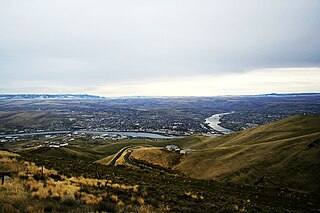
The Ravine Bluffs Development was commissioned in 1915 by Frank Lloyd Wright's attorney, Sherman Booth Jr. It is located in Glencoe, Illinois. Six houses, three poured concrete sculptures, and one bridge were built. Five of the houses were for rent when built. All 5 rental houses share the same basic floor plan as "A Fireproof House for $5000".

United Office Building, now known as the Giacomo, is a historic Mayan Revival, a subset of art deco, skyscraper in Niagara Falls, New York, US.

The Robert Lee McKenzie House is a historic house in Panama City, Florida, at 17 East 3rd Court. It was added to the U.S. National Register of Historic Places on August 21, 1986. Robert Lee McKenzie was the first mayor of Panama City and a civic leader for fifty years. The house is a two-story clapboard frame dwelling built in the Dutch Colonial style typical of turn-of-the-20th-century houses in Northern Michigan. It was built in 1909 by Belle Booth who married R. L. McKenzie in 1912; the house was enlarged in 1925.

The Lewis House, also known as Spring House, is a historic home in Tallahassee, Florida, located north of I-10, at 3117 Okeeheepkee Road. It was built in 1954. On February 14, 1979, it was added to the U.S. National Register of Historic Places. It was designed by Frank Lloyd Wright for George Lewis II, President of the Lewis State Bank, and his wife Clifton. The National Trust for Historic Preservation describes its significance: "The novel hemicycle form of Spring House represents a late, and little-known, stage in Wright’s long, prolific career. Although there are approximately 400 intact houses attributed to Wright throughout the country, only a fraction were from his hemicycle series."
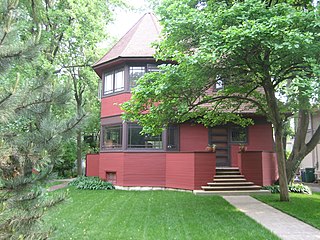
The Robert P. Parker House is a house located in the Chicago suburb of Oak Park, Illinois, United States. The house was designed by American architect Frank Lloyd Wright in 1892 and is an example of his early work. Real-estate agent Thomas H. Gale had it built and sold it to Robert P. Parker later that year. The house was designed by Wright independently while he was still employed by Adler and Sullivan, something architect Louis Sullivan forbade. The Parker House is listed as a contributing property to a U.S. federally Registered Historic District.

The Roloson Houses, also known as Robert Roloson Houses, are houses in Chicago, Illinois, United States. The house was built in 1894 by Frank Lloyd Wright for Robert W. Roloson.

The Senator William P. Frye House is a historic house on 453-461 Main Street in Lewiston, Maine. Built in 1874, it is a fine example of Second Empire architecture in the city, designed by local architects Fassett & Stevens for William P. Frye, a mayor of Lewiston and a United States Senator. The house was listed on the National Register of Historic Places in 1976.

The Grand Trunk station is a historic railroad station at 103 Lincoln Street in Lewiston, Maine. It was built in 1874 for a spur line connecting Lewiston and Auburn to the Grand Trunk Railway, to which it was leased. It is through this station that many of the area's French Canadian immigrants arrived to work in the area mills. The station was added to the National Register of Historic Places in 1979.
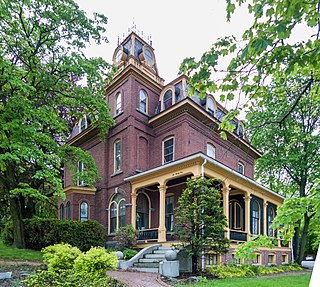
The Frank L. Dingley House is an historic house at 291 Court Street in Auburn, Maine. Built in 1867, it is a high-quality local example of Second Empire architecture. It is most significant as the long-time home of Frank L. Dingley, long-time editor of the Lewiston Evening Journal, the state's second-largest newspaper at the time. The house was listed on the National Register of Historic Places in 1980.

The Main Street Historic District is a small residential historic district south of the downtown area of Auburn, Maine. The fourteen houses in the district represent a cross-section of residential development during Auburn's growth between about 1825 and 1925. The district extends along Main Street, from Drummond Street south just past Elm Street, and includes a few houses on Elm and Vine Streets. The district was added to the National Register of Historic Places in 1989.

The First Callahan Building is an historic commercial and residential building at 276 Lisbon Street in Lewiston, Maine. Built in 1892 to a design by noted local architect George M. Coombs, the Renaissance Reviva brick building was part of a major development on the city's main commercial street by the Callahan brothers, owners of a local gentleman's furnishings store. The building was listed on the National Register of Historic Places in 1986.
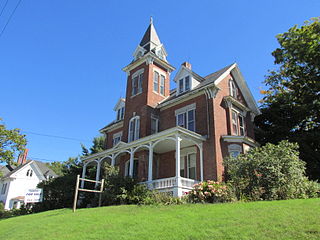
The James C. Lord House is a historic house at 497 Main Street in Lewiston, Maine. Built in 1885 for a prominent local businessman, it is a high quality blend of late 19th-century architectural styles. It was listed on the National Register of Historic Places in 1978.
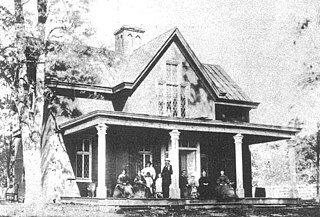
Tudor Hall is a historic home located at Bel Air, Harford County, Maryland, United States. It is a 1 1⁄2-story Gothic Revival cottage built of painted brick. The house was built as a country retreat by Junius Brutus Booth (1796–1852) from Plates 44 and 45, Design XVII, of The Architect, by William H. Ranlett, 1847. However, Booth never lived in Tudor Hall, because he died before it was completed. His son Edwin Booth lived there only briefly on his return from California before he moved the family back into Baltimore. But his other son, John Wilkes Booth, lived there with his mother, brother Joseph, and two sisters from December 1852 through most of 1856.

The Main Street–Frye Street Historic District is a historic district comprising houses on Frye Street and parts of College Street and Main Street in Lewiston, Maine. This area was part of the most fashionable residential district of the city in the second half of the 19th century, and was home to many of the city's elite. Its architectural styles are diverse, with a significant number of homes designed by local architect George M. Coombs. The district was added to the National Register of Historic Places in 2009.

Lewiston Mound is a prehistoric burial mound built by the indigenous peoples of the Hopewell tradition. It is located on the grounds of the Earl W. Brydges Artpark State Park, at Lewiston in Niagara County, New York.
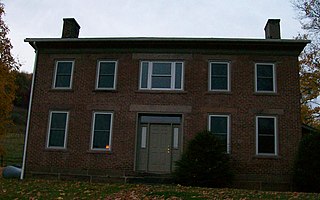
The Booth Homestead, also called the Booth Home Place, is located at 8433 Wheeling Township Road in Guernsey County, Ohio, United States. Named a historic site in 1979, it was built for one of the area's largest landowners.

The Frank Picklum House is a historic building located in the West End of Davenport, Iowa, United States. Picklum, who was a bricklayer and later a contractor, was the first person to live in the house and may have built it. Rooms were available for rent in the house by the late 1890s, but Picklum still lived here. The house was built in the McClellan style that was popular in late 19th century Davenport. The large Colonial Revival-style porch with the polygonal bay on the west side updated what is essentially a simple style. It has been listed on the National Register of Historic Places since 1984.

The John E. Booth House is a historic house located in Provo, Utah. John E. Booth was a significant Provoan, and was extensively involved in Provo's community and religious affairs. Located at 59 West and 500 North and less than one acre in size, the John E. Booth House was built in 1900, and happens to be the only 2 1⁄2-story Victorian Mansion in Provo, Utah. This house is significant not only as a Victorian mansion, but because its "Bricks were individually painted to create a variegrated design effect". The house was added to the National Register of Historic Places in 1982. The house was designated to the Provo City Historic Landmark Register on May 26, 1995.

The Sternwheeler Jean is a historic steamboat that operated on the Willamette River, in the U.S. state of Oregon. It is a 168-foot (51 m)-long tugboat, built in 1938 for the Western Transportation Company and in service until 1957. In August 1989, it was listed on the U.S. National Register of Historic Places in Nez Perce County, Idaho. At that time, it was located in Lewiston, Idaho, having been there since 1976. In Lewiston, its location changed from time to time, and Hells Gate State Park was among the locations where Jean was moored. As of 1997, it was still in Lewiston, afloat on the Snake River, but its operating equipment had been removed. Its private owner at that time, the James River Corporation, sold the tug in 1998. In July 2004, Jean was moved from Lewiston to Portland, Oregon. Subsequently, its twin paddle wheels have been removed.
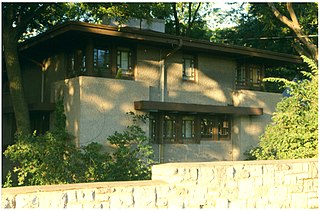
The Rock Crest–Rock Glen Historic District is a nationally recognized historic district located in Mason City, Iowa, United States. It was listed on the National Register of Historic Places in 1979. At the time of its nomination it contained 10 resources, which included eight contributing buildings, one contributing site, and one non-contributing building. All of the buildings are houses designed in the Prairie School style, and are a part of a planned development. Joshua Melson, a local developer, bought the property along Willow Creek between 1902 and 1908. Initially, there were only going to be 10 houses built, but the number grew to 16. While only half the houses planned were actually constructed, it is still the largest cluster of Prairie School houses in the country. The one non-contributing house is the 1959 McNider House, a Modern movement structure that was built where one of the planned houses was to be built, but never was. The architects who contributed to the district include Walter Burley Griffin, who provided the initial plan for the development; Barry Byrne, who took over from Griffin; Marion Mahony Griffin, Walter Griffin's wife and an architect in her own right; and Einar Broaten. Frank Lloyd Wright had a design that was never built here. The plans were used to build the Isabel Roberts House in River Forest, Illinois instead.

